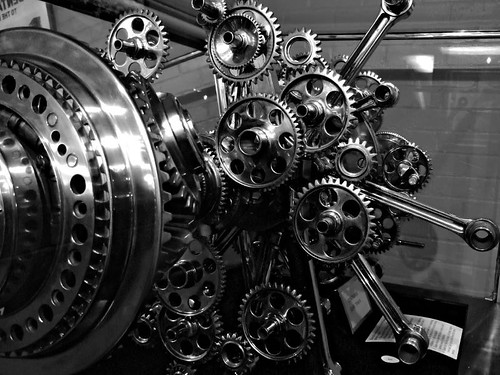Wow, look at this. If this had been built today people would call it steampunk style, but it's from 1923. Well this is actually a recreation as the original was crashed, but wow, just wow!


 Story:
http://www.switchimage.org/Lefebvre_1_E.html
Story:
http://www.switchimage.org/Lefebvre_1_E.html
Wow, look at this. If this had been built today people would call it steampunk style, but it's from 1923. Well this is actually a recreation as the original was crashed, but wow, just wow!


 Story:
http://www.switchimage.org/Lefebvre_1_E.html
Story:
http://www.switchimage.org/Lefebvre_1_E.html
In reply to 914Driver:
The power plant was a valve - less six-cylinder sleeve engine; while it could not reach high revolutions, it developed phenomenal torque. The engine was very quiet and produced 80 bhp.
No idea if it was bespoke or off the shelf. It doesn't say.
Amazing. I love how almost all of the body panels can be made with flat sheet aluminum formed in a single plane.
From the article:
He was the first in the racing world to abandon the traditional chassis with a separately mounted body, and build a monocoque body shaped like the fuselage of an aircraft. It was built like a plane, as well. Its light wooden frame was metal braced and clad with riveted sheets of aluminum, forming a strong unit while keeping the weight below 750 kg. The bottom was completely flat, giving the air stream a smooth passage underneath the car. Wooden vanes streamlined the suspension attach points to improve the airflow.
Very cool.
93EXCivic wrote: In reply to 914Driver:The power plant was a valve - less six-cylinder sleeve engine; while it could not reach high revolutions, it developed phenomenal torque. The engine was very quiet and produced 80 bhp.No idea if it was bespoke or off the shelf. It doesn't say.
I reread the article, Valveless? Anyone got 10 minutes to explain that one?
914Driver wrote:93EXCivic wrote: In reply to 914Driver:I reread the article, Valveless? Anyone got 10 minutes to explain that one? Sleeve engine. It has moving sleeves in the top end instead of valves. Think of a 2big stroke with moving ports.The power plant was a valve - less six-cylinder sleeve engine; while it could not reach high revolutions, it developed phenomenal torque. The engine was very quiet and produced 80 bhp.No idea if it was bespoke or off the shelf. It doesn't say.
HappyAndy wrote:914Driver wrote:93EXCivic wrote: In reply to 914Driver:I reread the article, Valveless? Anyone got 10 minutes to explain that one? Sleeve engine. It has moving sleeves in the top end instead of valves. Think of a 2big stroke with moving ports.The power plant was a valve - less six-cylinder sleeve engine; while it could not reach high revolutions, it developed phenomenal torque. The engine was very quiet and produced 80 bhp.No idea if it was bespoke or off the shelf. It doesn't say.

Didn't feel like digging for a better diagram.
Edit: berkeleying hotlinks... See video: http://www.youtube.com/watch?v=NSMYjRNQ8Rs
My high school girlfriend's dad had a 1929 Willys-Knight with a sleeve valve engine. It was a very smooth running engine, but it was inherently a smoker. Guess they weren't worried too much about emissions back then.
914Driver wrote:93EXCivic wrote: In reply to 914Driver:I reread the article, Valveless? Anyone got 10 minutes to explain that one?The power plant was a valve - less six-cylinder sleeve engine; while it could not reach high revolutions, it developed phenomenal torque. The engine was very quiet and produced 80 bhp.No idea if it was bespoke or off the shelf. It doesn't say.
Probably a two-stroke, hence the lack of valves and the torque.
Sleeve valve engines have ports in the sides of the heads (like two strokes), but also have holes in the cylinder "sleeve" or bore. The sleeve is rotated in a similar way that a normal valve train is (a bit more complex obviously) to line up the holes in the bore with the holes in the head.
I believe they are supposed to be a bit more efficient, as you can imagine the ports would flow a LOT better then a poppet valved head. But obviously they are a good amount more complex also.
The most successful sleeve valve engine that I know is the Bristol Centaurus that was installed in the Hawker Sea Fury.
Here is a shot of the gear (valve) train (!):

Here you can see the ports and the sleeve (yellow):

Here is a Sea Fury:

It should be noted that a number of the flying Sea Fury's have had the Centaurus engine replaced with "normal" valved American engine. Centaurus engined planes can be distinguished by the 5 bladed prop, re-engined ones are 4 bladed..
aircooled wrote: Sleeve valve engines.... is (a bit more complex obviously).....But obviously they are a good amount more complex also. The most successful sleeve valve engine that I know is the Bristol Centaurus that was installed in the Hawker Sea Fury. Here is a shot of the gear (valve) train (!):/>
!!!!! ![]()
Voisin was a major innovator and is famous for his somewhat quirky, but unique designs.
Here are a few others. Check out the "Mylord". If the Munsters could have afforded it....
http://www.supercars.net/Search2?INPUT=Voisin
He built several cars for the Grand Prix de Tours in 1923, you can find some period pics here:
http://www.motorsnaps.com/v/1920s+Racing+Cars+and+drivers/1923/French+Grand+Prix/g1923gp+de+l_acf_+tours+-+andr__+morel+voisin+laboratoire+d.jpg.html
You'll need to log in to post.